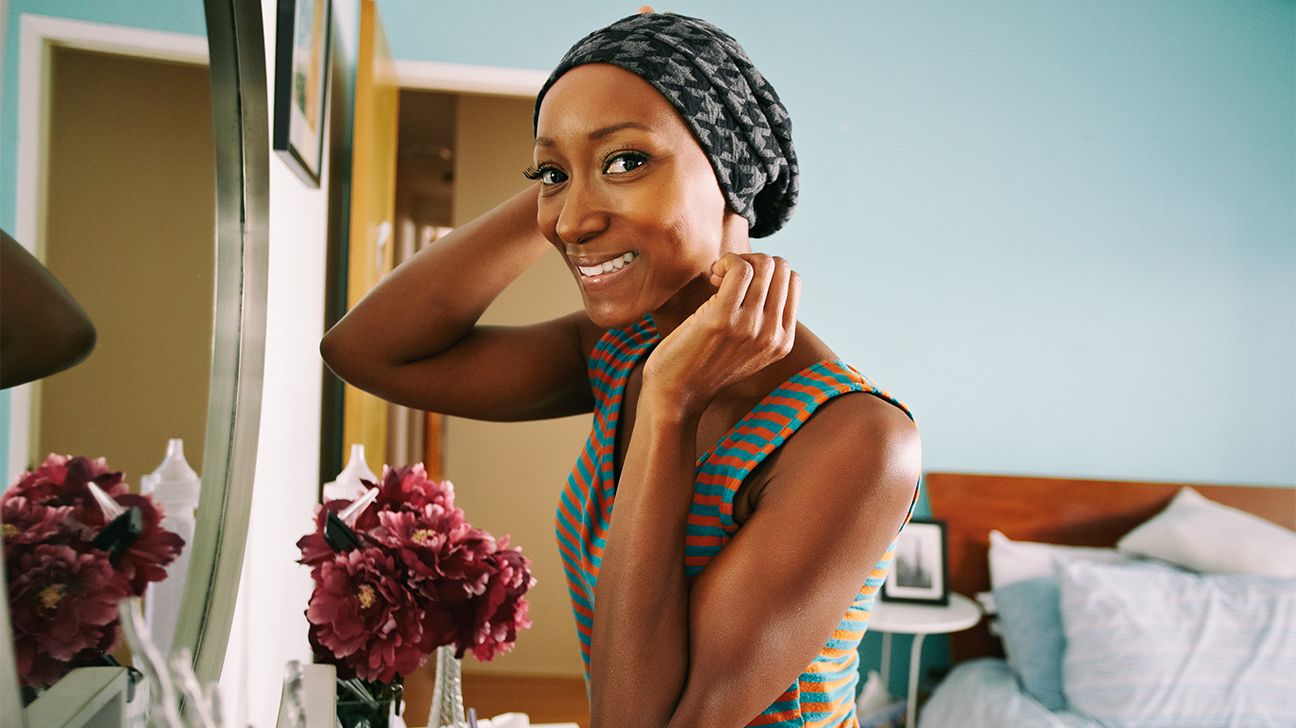Breast Cancer Glossary: 41 Terms You Should Know
July 06, 2020
Content created for the Bezzy community and sponsored by our partners. Learn More

Utterly overwhelmed is how I felt when I faced the uncertainty and devastation of my breast cancer diagnosis 5 years ago.
I dove into online communities to connect, observe, research, and be heard. When I did, I was lost on some of the language. There were so many terms, acronyms, and abbreviations to learn.
Some things that now seem obvious to understand weren’t while dealing with a brain processing the new trauma of my cancer diagnosis.
If you’re wondering what in the world a red devil, foob, expander, and ooph is, I’ve got you.
I assembled this glossary of some common language used in the breast cancer community in hopes of easing the way for the newly diagnosed, and empowering you to jump in on those online discussions with some general breast cancer terms.


ACT
A common group of chemo drugs including Adriamycin, Cytoxan, and Taxol.
BRCA1 and BRCA2
This is an abbreviation for BReast CAncer gene. BRCA1 and BRCA2 are two genes that have been found to impact the chances of developing breast cancer, but they don’t cause cancer.
Cancerversary
There are many possible cancer anniversaries one might note. Defining those days to celebrate or commemorate is very personal and defined individually. They can trigger mixed emotions of trauma, wins, relief, joy, and fear.
The main canserversaries I observe are my date of diagnosis and date of my DIEP flap recon.
Chemo brain
This is cognitive dysfunction associated with chemo treatment that causes:
- difficulty concentrating
- memory lapses
- inability to multitask
- trouble remembering names, recalling words, or spelling common words
Chemo brain is real for me. I’m the queen of brain glitches.
Some experience chemo brain for the short term. Others, like me, have lingering chemo brain.
Here’s what else you need to know: hormone therapy, radiation, targeted therapy treatments, post-traumatic stress disorder, as well as depression and anxiety, can also contribute to cognition issues.
Chemo teeth
Dental problems that may occur from chemo treatment. After chemo, I began to have dental problems I had never had before, including chipping teeth, increased cavities, and sensitive teeth.
I now find it’s often necessary to use a straw when drinking beverages as my teeth are sensitive post-chemo.
Co-survivor
Your ride-or-die support person.
DCIS
Ductal carcinoma in situ. Abnormal cells that begin growing along the lining of the milk ducts, but haven’t spread to surrounding breast tissue.
DD
Dose-dense. Chemo that’s administered with less recovery time between rounds than in a standard chemo treatment plan.
De novo
A person says they were “de novo” when their first and only breast cancer diagnosis was stage 4 and they’re living with metastatic disease.
Not all people living with stage 4 are diagnosed de novo. Their first diagnosis could have been early stage 1 to 3 and they later experienced a stage 4 metastatic recurrence.
Dx
Medical abbreviation for diagnosis.
Early stage breast cancer
Breast cancer stage 1–3 that hasn’t metastasized to bones and organs. Early stage breast cancer is typically any breast cancer that’s contained in the breast.
ER/PR
Estrogen receptor/progesterone receptor. Someone might ask what your hormone receptor status is. They’re basically asking if your cancer is ER/PR-positive, or ER/PR-negative.
Exchange surgery
Getting expanders removed and swapped out for breast implants.
Expanders
Deflated balloon-like structures placed under or over the pectoral muscle to make room for breast implants following a mastectomy.
They have a port that will be filled with saline injections over time to slowly fill up and expand tissue.
Explant
Removing breast implants. I explanted my implants and opted for a DIEP flap reconstruction. I have friends that have explanted to go flat.
Fills
Saline injected into your expanders over time to stretch chest tissue. Example: “I went in for fills today, I’m a little sore.”
Flap recon
A type of post-mastectomy reconstruction that involves making a breast mound out of tissue harvested from another part of your body.
Types of flap recon include:
- Deep inferior epigastric artery perforator (DIEP) — skin, fat, and blood vessels from the abdomen
- Transverse rectus abdominis muscle (TRAM) — muscle, skin, and fat from the lower abdomen
- Gluteal artery perforator (GAP) — skin and fat from the buttocks
- Transverse upper gracilis (TUG) — skin, fat, muscle, and blood vessels from the inner thigh
- Latissimus dorsi flap reconstruction — skin, fat, muscle, and blood vessels from the upper back
Flat/flattie/uniboob
This is pretty self-explanatory, but what you need to know is there’s a flat community that has been doing advocacy work to normalize bilateral or unilateral flat so newbies know that flat reconstruction is an option on the recon menu.
See @flatclosurenow on Instagram for inspiration and resources.
Foobs
Fake boobs.
HER2
Human epidermal growth factor receptor 2 is a protein that can play a role in the development of your breast cancer. Knowing if your HER2 status is negative or positive helps determine treatment plans.
HT
Hormone therapy. These are drugs — such as tamoxifen — that are used to block estrogen in some tissues while aromatase inhibitors lower estrogen levels. These help prevent recurrence or slow progression of cancer to prolong life.
IDC
Invasive ductal carcinoma. Cancer that begins in the milk duct and has spread to other areas of the breast.
ILC
Invasive lobular carcinoma. Cancer that begins in the milk-producing glands of the breast, then spreads to other parts of the breast.
Lymphedema
Lymphatic dysfunction. Swelling in the arms or other parts of the body after lymph nodes are surgically removed or damaged by radiation. It may never develop or it could develop years later.
MBC
Metastatic breast cancer. Cancer that has spread to other parts of the body such as the bones, liver, brain, or lungs. MBC is stage 4 cancer, which is the most serious stage.
Mets
Short for metastatic, metastasized, and metastasis. A person might say, “I have bone mets” or “that person is a member of the mets (stage 4) community.”
Mx
Mastectomy. A breast cancer treatment that involves removing the entire breast.
NED
No evidence of disease.
Ooph
Oophorectomy is the surgical removal of the ovaries. It’s one way some people with ER-positive cancer suppress estrogen in their bodies.
PS
Plastic surgeon.
Rads
Radiation. Radiation therapy is a breast cancer treatment that uses concentrated radiation beams to kill cancer cells.
Recon
Breast reconstruction where breast mounds are made after a mastectomy. They can be made from implants or your own skin and fat tissue.
Red devil
That’d be the A in ACT: Adriamycin. It’s one of the most powerful chemo drugs invented. It’s called the red devil because of its bright red appearance.
Adriamycin causes many of the classic symptoms you may associate with chemo: nausea, vomiting, hair loss, etc.
Scanxiety
The scanxiety is real! This is the general anxiety you might feel going in for any type of scan or waiting on scan results.
Irritability and weird breathing, anyone? That’s how it manifests with me. The good news is, I’ve learned some coping skills over the years.
Survivor
This word is generally understood outside the breast cancer community to describe someone who had stage 1–3 breast cancer and is done with surgeries or active treatment.
Survivorship
This means living with, through, and beyond cancer. It includes people who continue to have treatment over the long term to either reduce the risk of recurrence or to manage chronic disease.
I might say, “I’m 5 years into my survivorship,” and what I mean is I’m 5 years out from my original diagnosis.
Targeted therapy
Targeted therapy is non-cytotoxic chemotherapy drugs that can target cancer cells, but don’t affect healthy cells.
You may hear targeted therapy in reference to drugs that can be used to treat HER2-positive breast cancers such as:
- Herceptin
- Nerlynx
- Tykerb
- Perjeta
- Kadcyla
TCHP
A common chemo treatment course for triple positive breast cancer consisting of Taxotere, carboplatin, Herceptin, and Perjeta.
Thriver
This word is used within the community to describe anyone of any stage who has had a breast cancer diagnosis.
It’s often used to evoke a positive and empowering vibe that we’re bigger than our disease and it doesn’t define us. Within the breast cancer community, people might identify as a survivor or a thriver.
TNBC
Triple-negative breast cancer is a type of breast cancer in which the cells don’t have ER/PR receptors or HER2 receptor traits.
Triple positive
When breast cancer is ER/PR-positive and HER2-positive.
Write your story
Try writing your cancer story basics using this guide. I keep mine saved in my phone so I can easily share my details when asked in online forums.
Here’s mine:
“I was Dx at age 42 w/ ER/PR+, HER2-, ILC. I did DD ACT, rads, and I’m on the 10 yr plan w/ HT, and thriving 5 yrs into my survivorship. My cancerversary is date of Dx on Sept. 18, 2014. I’ve had expanders w/ fills, implant exchange, explanted, and had DIEP flap recon. I have chemo brain. I had an ooph at 44 that put me in early menopause. I identify as an ally to the flat community.”
Article originally appeared on July 6, 2020 on Bezzy’s sister site, Healthline. Last medically reviewed on June 25, 2020.
Medically reviewed on July 06, 2020
7 Sources


Like the story? React, bookmark, or share below:
Have thoughts or suggestions about this article? Email us at article-feedback@bezzy.com.
About the author